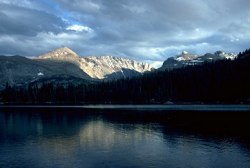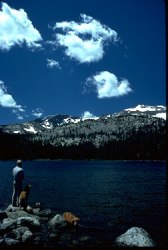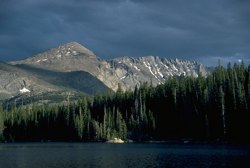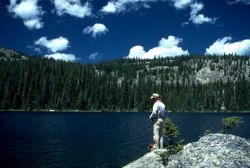|
This is part 2 of an article by Al Marlowe on the
Cloud Peak Wilderness. To read part 1, click
here.
There are other trails beside Solitude that will make
for shorter hikes. All will take the backpacker into some of the finest
scenery in the Bighorn Mountains. A mile or so past the wilderness
boundary, along the Solitude Trail, a trail leads south to the Seven
Brothers Lakes. Return by way of Buffalo Park, back to the corrals. A
campground at the lakes makes this 12-mile ride ideal for an
overnighter.
Circle Park Campground, about three miles south of
Hunter Corrals and three miles west of U. S. 16, could be the starting
place for a multi-day trip into the South Fork Ponds area. The glacially
carved cirques of Big Horn Peak, about five miles to the west, can be
seen from the ponds.
Several outfitters serve the Cloud Peak area. Most
offer pack trips and guided hunts in the fall. A couple have guest
facilities. Whether you use an outfitter or plan a do-it-yourself trip,
the Cloud Peak Wilderness will be a memorable experience.
Fishing is one of the best reasons I can think
of to visit the wilderness. The entire wilderness has alpine lakes
hidden below the peaks. Best of all the majority have fish. When Karl
and I made our backpack trip our destination was Highland Park Lake, a
nine-mile hike from the trailhead at Bighorn Reservoir on the north side
of the Cloud Peak WA.
We made camp a few hundred yards from the lake's
shore. Although we had plenty of food in our packs we wanted to
supplement it with a couple of meals of fresh-caught trout. Fortunately
Highland Park was loaded with brookies that seemed to feed 24 hours each
day. The surface was constantly dotted with the rise forms of trout
gorging on tiny insects that could be matched only with something like a
No. 24 Midge, or even smaller.
 Karl
tried his luck with tiny flies one evening but all he got for his
efforts were brookies not exceeding four or five inches. They ignored
larger offerings. While they were picky about the size of flies taken,
the larger fish (brookies and rainbows of eight to 11 inches) hit every
lure we put in front of them. Karl
tried his luck with tiny flies one evening but all he got for his
efforts were brookies not exceeding four or five inches. They ignored
larger offerings. While they were picky about the size of flies taken,
the larger fish (brookies and rainbows of eight to 11 inches) hit every
lure we put in front of them.
Other nearby lakes are Myrtle and Peggy. Myrtle has
golden trout that are temperamental - they feed whenever in the mood
and they decide when they are in the mood, which is seldom when anglers
are there. Peggy has larger brookies and rainbows than Highland Park but
they are more reluctant to hit a fly or lure.
Having decided that we were going to eat fish for
dinner one evening Karl and I worked the shoreline of Highland Park all
day. For hours we cast spinners and spoons at the fish. While they were
eager to hit whatever we presented to them it still took all of our
experience and skill for both of us to catch and release about 250 fish.
And yes, we did keep a few for the skillet.
 Access
- The Cloud Peak Wilderness is located in Bighorn, Johnson and
Sheridan Counties in Northern Wyoming, within the Bighorn National
Forest. It lies a few miles west of I-90 between the cities of Buffalo
and Sheridan. It is bounded on the west by US 20, US 14 on the north,
and US 16 on the south. Access
- The Cloud Peak Wilderness is located in Bighorn, Johnson and
Sheridan Counties in Northern Wyoming, within the Bighorn National
Forest. It lies a few miles west of I-90 between the cities of Buffalo
and Sheridan. It is bounded on the west by US 20, US 14 on the north,
and US 16 on the south.
There are Forest Service roads giving access to
wilderness trails. Not all are open to the public because landowners
lock the gates. Consult a NF map concerning road closures or contact the
Forest Supervisor, Bighorn National Forest, 1969 S. Sheridan Ave.,
Sheridan WY 82801, phone (307) 672-0751. Be sure to request a free map
covering the Cloud Peak Wilderness.
About 20 NF campgrounds surround the wilderness. Be
aware that horses are prohibited within the campgrounds if that's how
you plan to tour the wilderness. Check with the Forest Supervisor for
information on parking horse trailers and tow vehicles.
 Climate
- Wind is the one condition that is a constant. One Wyoming resident
said, "It doesn't always blow this way, sometimes it comes from the
opposite direction." Even though the wilderness is usually breezy,
it's not unpleasant. Climate
- Wind is the one condition that is a constant. One Wyoming resident
said, "It doesn't always blow this way, sometimes it comes from the
opposite direction." Even though the wilderness is usually breezy,
it's not unpleasant.
Because of the northwest to southeast orientation of
the mountain range, storms can sneak in with little warning. Be prepared
for anything, even in mid-summer. Usually, though, the weather will be
pleasant.
One thing that will be noticed is the extreme clarity
of the air. The sky appears to be a darker blue, the clouds whiter. With
little heavy industry in Wyoming, there are few sources belching
unpleasant particles into the atmosphere.
July and August are the recommended times to visit
Cloud Peak Wilderness. What snow remains then will rarely block access
except on some of the higher trails. Daytime temperatures can range from
the 40s to the 60s. The higher you go, the cooler the temperatures you
will encounter.
Wilderness Camping- Campsites in the
wilderness must be kept at least 100 feet from any water source. Bury
all human wastes. Pack out any trash that can't be burned. When breaking
camp, try to hide any traces of your visit.
Wildlife - The wilderness is home to many
species of song birds and small animals like chipmunks, ground
squirrels, and marmots. Deer, elk, and moose are common. Black bears
inhabit the area. Your sleeping and cooking areas should be separated to
discourage Bruin from prowling through your camp.
Other Services- Gas, groceries, and meals are
available at most of the towns serving the area. Fishing licenses are
readily available in some surprisingly out of the way places. Emergency
medical services are in Sheridan, Buffalo, Worland, Lovell, and
Greybull.
All content and photos � 2000 Al
Marlowe
Al Marlowe has authored numerous books and articles about fishing in
Colorado and Wyoming. For more info on Al see www.hiddenlakespress.com
 Buy
a topo map for Cloud Peak Wilderness, or purchase
a book Buy
a topo map for Cloud Peak Wilderness, or purchase
a book
|